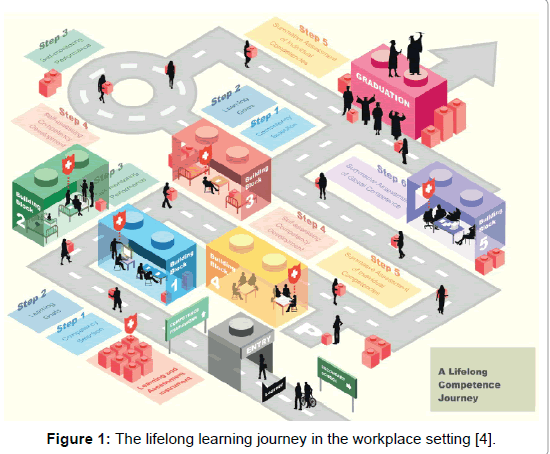Short Communication Open Access
How to Organize Continuous Workplace Learning in Clinical Practice?
1Midwifery department, University College Arteveldehogeschool, 9000 Ghent, Belgium
2Department of Educational Studies, Faculty of Psychology and Educational Sciences, Ghent University, 9000 Ghent, Belgium
- *Corresponding Author:
- M Embo
Head of Midwifery Department
University College Arteveldehoge school Ghent, Belgium
Tel: 32 485 630 562
E-mail: mieke.embo@arteveldehs.be
Received date: October 01, 2015; Accepted date: October 23, 2015; Published date: October 30, 2015
Citation: Embo M, Valcke M (2015) How to Organize Continuous Workplace Learning in Clinical Practice? J Comm Pub Health Nursing 1:102. doi:10.4172/2471-9846.1000102
Copyright: © 2015 Embo M, et al. This is an open-access article distributed under the terms of the Creative Commons Attribution License, which permits unrestricted use, distribution, and reproduction in any medium, provided the original author and source are credited.
Visit for more related articles at Journal of Community & Public Health Nursing
Workplace learning is high on the agenda of Ministers of Education and Employment. Worldwide, the ultimate goal is to educate competent professionals who are fit for practice. That is why, a few decades ago, competency-based education has been introduced. Competency-based or outcome-based education has encouraged a more sophisticated perspective on student progress and student monitoring in view of supporting the attainment of exit outcomes [1]. The benefits of a more seamless continuum of education from undergraduate through postgraduate education to continuing professional development have been widely accepted [2]. But, in practice, the implementation of such a continuum has proved elusive and difficult to achieve [1]. The question mainly pertained on how workplace learning is to be organized to foster continuous competency development? The answer to this research question can be found in a recently finalized doctoral research programme ‘Integrating workplace learning, assessment and supervision in health care education’ [3].
Reviews of the relevant workplace literature and empirical research in the context of undergraduate midwifery education (Belgium) resulted in the design of a holistic and competency-based model offering the possibility to facilitate continuous learning at the workplace. We have shown that it is possible to integrate the numerous components of workplace learning into an evidence-based and feasible workplace learning model: the ‘Integrated learning Assessment and Supervision Competency Model’ [1]. Integration, collaboration and continuity are the cornerstones of this workplace learning model. The results make clear that promoting continuous competency development requires (1) an integration of competencies, (2) learning (reflection and feedback on performance and on competency development), (3) assessment (self-, formative and summative assessment), and (4) supervision (observers, learning guides and assessment committee). This results in a model with a programmatic view on the workplace learning curriculum and a focus on critical conditions to support continuous learning. The latter was found to be needed because respondents noted important barriers while implementing the model. They stated that successful implementation rely on the extent to which essential conditions are met. The model has important implications for the design of the workplace learning programme. The latter needs to be revised in such a way that (1) a formative reflection and feedback continuum is established, (2) active involvement in learning and supervision is encouraged, and (3) collaboration in learning is facilitated. Our empirical research findings suggest the resulting formative learning is valuable and affects the results of summative assessment. A twofold assessment strategy (assessment of single competencies and holistic judgment of professional competence) creates an assessment continuum at the workplace.
The following graphical representation shows how the interplay of the above mentioned components results in a lifelong learning journey in the workplace [4] (Figure 1).
To conclude, this Integrated Learning Assessment and Supervision Competency model, also called Embo’s continuous workplace learning model, provides new perspectives on continuous and competencybased workplace learning. At this moment, the generalizability is explored by implementing this model in twelve midwifery schools and one speech pathology school in Flanders. The authors state that this model contributes to the competence future in health care education and practice.
Figure 1: The lifelong learning journey in the workplace setting [4].
References
- Harden RM (2007) Learning Outcomes as a tool to assess progression. Med Teach 29:678-682.
- Harden RM (2006) Trends and the future of postgraduate medical education. Emerg Med 23:798-802.
- Embo M (2015) Integrating workplace learning, assessment and supervision in health care education. Maastricht: Universitaire Pers.
- Embo M, Driessen E, Valcke M, van der Vleuten C (2015) Integrating Learning, Assessment and Supervision in a Competency Framework for Clinical Workplace Education. Nurse Educ Today 35: 341-346.
Relevant Topics
- Chronic Disease Management
- Community Based Nursing
- Community Health Assessment
- Community Health Nursing Care
- Community Nursing
- Community Nursing Care
- Community Nursing Diagnosis
- Community Nursing Intervention
- Core Functions Of Public Health Nursing
- Epidemiology
- Epidemiology in community nursing
- Health education
- Health Equity
- Health Promotion
- History Of Public Health Nursing
- Nursing Public Health
- Public Health Nursing
- Risk Factors And Burnout And Public Health Nursing
- Risk Factors and Burnout and Public Health Nursing
Recommended Journals
- Epidemiology journal
- Global Journal of Nursing & Forensic Studies
- Global Nursing & Forensic Studies Journal
- global journal of nursing & forensic studies
- journal of community medicine& health education
- journal of community medicine& health education
- Palliative Care & Medicine journal
- journal of pregnancy and child health
Article Tools
Article Usage
- Total views: 14232
- [From(publication date):
November-2015 - Jul 14, 2025] - Breakdown by view type
- HTML page views : 9661
- PDF downloads : 4571

